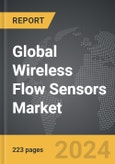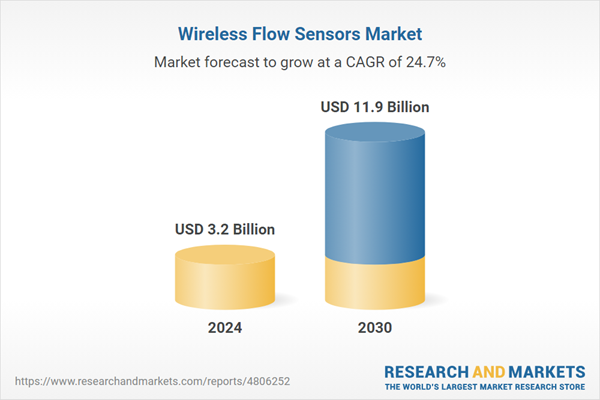Global Wireless Flow Sensors Market - Key Trends & Drivers Summarized
Why Are Wireless Flow Sensors Gaining Traction Across Various Industries?
Wireless flow sensors are becoming increasingly popular across a wide range of industries due to their ability to provide accurate and real-time monitoring of fluid flow without the need for extensive wiring. These sensors are widely used in applications such as water management, oil and gas, chemical processing, and HVAC systems to monitor liquid or gas flow rates and ensure efficient system operation. The shift towards smart factories, smart cities, and industrial automation is driving the demand for wireless flow sensors that offer flexibility, scalability, and ease of installation. As industries aim to improve operational efficiency, reduce maintenance costs, and enhance safety, wireless flow sensors are becoming essential tools in achieving these objectives.What Technological Innovations Are Enhancing Wireless Flow Sensor Capabilities?
Technological advancements in wireless communication, sensor materials, and data analytics are significantly enhancing the performance and reliability of wireless flow sensors. The development of low-power wide-area networks (LPWAN) such as LoRaWAN, Sigfox, and NB-IoT is enabling long-range, low-energy communication for wireless flow sensors, making them suitable for remote monitoring in hard-to-reach locations. Innovations in micro-electromechanical systems (MEMS) technology are leading to the miniaturization of sensors, allowing for more compact and efficient designs. Additionally, the integration of AI and machine learning algorithms in sensor networks is enabling predictive maintenance and anomaly detection, reducing downtime and optimizing resource management in industrial processes.What Are the Challenges and Opportunities in the Wireless Flow Sensors Market?
The wireless flow sensors market faces several challenges, including signal interference, limited battery life, and the need for regular calibration to maintain accuracy. Additionally, concerns over data security and privacy, particularly in critical infrastructure applications, can impact the adoption of wireless flow sensors. However, these challenges also present opportunities for growth and innovation. The increasing demand for smart water management, driven by water scarcity and regulatory compliance, is creating new growth opportunities for wireless flow sensors. The rise of Industry 4.0 and the digital transformation of manufacturing processes are driving the need for advanced flow monitoring solutions that can provide real-time data and analytics. Moreover, the expansion of renewable energy projects, such as wind and solar farms, is driving the demand for wireless flow sensors that can monitor cooling systems and optimize energy production.What Is Driving the Growth of the Wireless Flow Sensors Market?
The growth in the Wireless Flow Sensors market is driven by several factors, including the increasing adoption of smart and connected technologies in industrial and environmental monitoring, rising demand for efficient water and energy management solutions, and technological advancements in wireless communication protocols and sensor design. The need for accurate and real-time flow monitoring to optimize operations, reduce maintenance costs, and ensure regulatory compliance is significantly boosting market demand for wireless flow sensors in sectors such as water management, oil and gas, and chemical processing. Technological innovations such as LPWAN, MEMS technology, and AI-driven analytics are enhancing the capabilities and reliability of wireless flow sensors, making them more attractive to industries seeking scalable and flexible solutions. The expansion of smart cities, the growth of Industry 4.0, and the increasing focus on sustainability and resource efficiency are also driving market growth as stakeholders seek advanced and integrated wireless flow monitoring solutions.Report Scope
The report analyzes the Wireless Flow Sensors market, presented in terms of market value (US$ Thousand). The analysis covers the key segments and geographic regions outlined below.- Segments: Technology (Wi-Fi, Bluetooth, ZigBee, WLAN, Other Technologies); Application (Water & Waste Water Management, Chemicals & Petrochemicals, Power Generation, Other Applications).
- Geographic Regions/Countries:World; United States; Canada; Japan; China; Europe (France; Germany; Italy; United Kingdom; and Rest of Europe); Asia-Pacific; Rest of World.
Key Insights:
- Market Growth: Understand the significant growth trajectory of the Wi-Fi Technology segment, which is expected to reach US$4.8 Billion by 2030 with a CAGR of a 25.9%. The Bluetooth Technology segment is also set to grow at 24.8% CAGR over the analysis period.
- Regional Analysis: Gain insights into the U.S. market, valued at $875.9 Million in 2024, and China, forecasted to grow at an impressive 23.3% CAGR to reach $1.8 Billion by 2030. Discover growth trends in other key regions, including Japan, Canada, Germany, and the Asia-Pacific.
Why You Should Buy This Report:
- Detailed Market Analysis: Access a thorough analysis of the Global Wireless Flow Sensors Market, covering all major geographic regions and market segments.
- Competitive Insights: Get an overview of the competitive landscape, including the market presence of major players across different geographies.
- Future Trends and Drivers: Understand the key trends and drivers shaping the future of the Global Wireless Flow Sensors Market.
- Actionable Insights: Benefit from actionable insights that can help you identify new revenue opportunities and make strategic business decisions.
Key Questions Answered:
- How is the Global Wireless Flow Sensors Market expected to evolve by 2030?
- What are the main drivers and restraints affecting the market?
- Which market segments will grow the most over the forecast period?
- How will market shares for different regions and segments change by 2030?
- Who are the leading players in the market, and what are their prospects?
Report Features:
- Comprehensive Market Data: Independent analysis of annual sales and market forecasts in US$ Million from 2024 to 2030.
- In-Depth Regional Analysis: Detailed insights into key markets, including the U.S., China, Japan, Canada, Europe, Asia-Pacific, Latin America, Middle East, and Africa.
- Company Profiles: Coverage of players such as ABB Ltd., Analog Devices, Inc., Emerson Electric Company, General Electric Company, Honeywell International, Inc. and more.
- Complimentary Updates: Receive free report updates for one year to keep you informed of the latest market developments.
Some of the 46 companies featured in this Wireless Flow Sensors market report include:
- ABB Ltd.
- Analog Devices, Inc.
- Emerson Electric Company
- General Electric Company
- Honeywell International, Inc.
- Kongsberg Gruppen ASA
- Maxim Integrated Products, Inc.
- Microchip Technology, Inc.
- NXP Semiconductors NV
- Panasonic Corporation
- Siemens AG
- STMicroelectronics
- Texas Instruments, Inc.
This edition integrates the latest global trade and economic shifts into comprehensive market analysis. Key updates include:
- Tariff and Trade Impact: Insights into global tariff negotiations across 180+ countries, with analysis of supply chain turbulence, sourcing disruptions, and geographic realignment. Special focus on 2025 as a pivotal year for trade tensions, including updated perspectives on the Trump-era tariffs.
- Adjusted Forecasts and Analytics: Revised global and regional market forecasts through 2030, incorporating tariff effects, economic uncertainty, and structural changes in globalization. Includes historical analysis from 2015 to 2023.
- Strategic Market Dynamics: Evaluation of revised market prospects, regional outlooks, and key economic indicators such as population and urbanization trends.
- Innovation & Technology Trends: Latest developments in product and process innovation, emerging technologies, and key industry drivers shaping the competitive landscape.
- Competitive Intelligence: Updated global market share estimates for 2025, competitive positioning of major players (Strong/Active/Niche/Trivial), and refined focus on leading global brands and core players.
- Expert Insight & Commentary: Strategic analysis from economists, trade experts, and domain specialists to contextualize market shifts and identify emerging opportunities.
Table of Contents
Companies Mentioned (Partial List)
A selection of companies mentioned in this report includes, but is not limited to:
- ABB Ltd.
- Analog Devices, Inc.
- Emerson Electric Company
- General Electric Company
- Honeywell International, Inc.
- Kongsberg Gruppen ASA
- Maxim Integrated Products, Inc.
- Microchip Technology, Inc.
- NXP Semiconductors NV
- Panasonic Corporation
- Siemens AG
- STMicroelectronics
- Texas Instruments, Inc.
Table Information
| Report Attribute | Details |
|---|---|
| No. of Pages | 223 |
| Published | December 2025 |
| Forecast Period | 2024 - 2030 |
| Estimated Market Value ( USD | $ 3.2 Billion |
| Forecasted Market Value ( USD | $ 11.9 Billion |
| Compound Annual Growth Rate | 24.7% |
| Regions Covered | Global |









